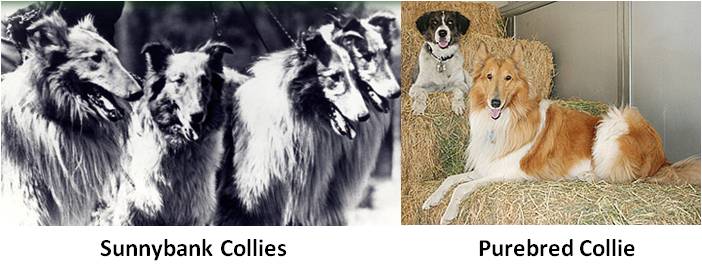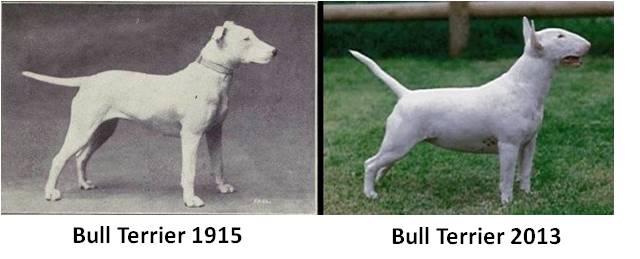As usual, two things came together to inspire today’s post. The first was an article in Science of Dogs magazine by Mus Musculus, Ph.D. In “100 Years of Breed ‘Improvement’,” he compares photographs of eight different breeds taken in 1915 and in 2013. The 1915 photographs of the bull terrier, basset hound, boxer, English bulldog, dachshund, German shepherd, pug and St. Bernard were taken from Breeds of All Nations by W.E. Mason.
Problems With the Overbred Dog
Dr. Musculus’s article describes how dogs bred for conformation—essentially for the show ring—have lost the build and the traits that empowered them to perform the functions for which the breed was created. Worse, defects have been bred into them resulting in physical or mental weaknesses or a propensity to suffer from certain diseases. The photographs also show that some of these overbred dogs have gone from attractive, muscular dogs to ugly parodies of what they used to be.
The second was a YouTube video called “You Shall Not Pass, Dog,” posted by happymedulla and viewed nearly 5,500,000 times. This pastiche shows dogs refusing to pass by a cat in a narrow passage or staircase. In it, one of the owners tries to reassure the dog by saying of the cat, “She won’t hurt you.” Hah.
The Biker Gang of the Feline World
When my husband and I were first married, we lived in a large apartment building in the Flatbush section of Brooklyn, NY. In the alley behind the buildings on our street lived a small army of feral cats. They performed a valuable service by preying on city vermin and this kept our building free of mice, rats, and even cockroaches. These cats were not pretty. Most of them bore scars, had lost part or all of an ear or the tip of a tail, and were scruffy with dirt and mange. They were the biker gang of the feline world.
One day, I came home from work and found one of the gang sitting in the middle of the walkway that ran from the sidewalk to a small porch by the front door.
This feral cat looked like Mickey Rourke in The Wrestler. He had clearly gone many rounds with his intended dinner as well as with other cats and lost more than one of them. He had, however, achieved possession of the walkway and was not about to give it up.
The Overbred Dog Approaches
Mickey barely deigned to notice me as I detoured around him and stopped on the porch to talk to a neighbor. As we chatted, another resident approached with a purebred dog on a leash. It was a small terrier, white and yappy, and it became excited when it turned around the hedge and saw the cat in its path. The owner, having no more street smarts than her dog, let him rush up to Mickey. It only took one swipe of Mickey’s forepaw for the dog ran ki-yiiing into the building with four red stripes on his nose.
That was interesting. We kept chatting as another resident came in with his purebred dog, small and yappy. The scene repeated itself with the overbred dog’s nose bleeding as it ran away.
The Mutt Scopes the Scene
 Moments later a third resident approached with his dog—a mutt with the genes of multiple breeds mixed happily in his compact body. He had a pointy nose, large ears, brown fur and a long straight tail. The mutt saw Mickey in the middle of the walkway and stopped dead. His owner waited and we all watched while the dog evaluated the situation.
Moments later a third resident approached with his dog—a mutt with the genes of multiple breeds mixed happily in his compact body. He had a pointy nose, large ears, brown fur and a long straight tail. The mutt saw Mickey in the middle of the walkway and stopped dead. His owner waited and we all watched while the dog evaluated the situation.
Then, walking slowly and carefully, the mutt made a wide circle around the cat, which watched him disdainfully every step of the way. Once he reached the porch safely, the dog continued into the building, ready for his dinner and a pain-free evening.
That experience told me something about the brainpower of mixed breeds compared to a purebred dog. Given a choice between looks and street smarts, I’ll take basic common sense every time.
It’s Been Going On for a Long Time
The phenomenon of dogs having the brains bred out of them is, unfortunately, not new. When I was a kid I read all the marvelous books by Albert Payson Terhune about his Sunnybank collies. These novels were written in the 1920s and even then the author was lamenting the breeding of collies for conformation. He said that a collie should have a “large coffin-shaped head” to hold the brains it needed to perform its job of herding sheep. It also needed strong sturdy legs to run up and down the hills on farms in the Scottish Highlands.
Looking at the pictures of Mr. Terhune’s Sunnybank collies, you can see exactly what he meant, especially compared to the current version of a collie with its effete head, needle-sharp nose and delicate legs.
 It’s hard to argue even that purebred dogs are more attractive. Can anyone reasonably claim that the current version of a bull terrier is better looking than the 2015 dog? The purebred beast looks like a mutated alien creature trying to see over its bowed nose. Who decided that a Roman nose was more attractive (much less functional) than a straight nose?
It’s hard to argue even that purebred dogs are more attractive. Can anyone reasonably claim that the current version of a bull terrier is better looking than the 2015 dog? The purebred beast looks like a mutated alien creature trying to see over its bowed nose. Who decided that a Roman nose was more attractive (much less functional) than a straight nose?
A Reason for Being
These dogs once had a reason for being and a purpose in life. They were bred to herd sheep, fight badgers, kill rats, control bulls, find birds, or rescue lost hikers, among many other things. Once they were separated from that function to become pets and show-ring dogs, the reason for their original conformation was lost.
Ironically, the definition of canine conformation states:
“Conformation trials, or dog shows, are designed to display purebred dogs with ideal characteristics of their respective breeds as determined by a purebred dog association such as the American Kennel Club or the United Kennel Club. Ultimately, the goal is to maintain and even improve each breed so that future lines remain of the highest quality.”
When their environment changed from Highlands farms to city apartments, collies no longer needed either strong legs or the brains to outsmart the sheep. When owners changed from practical farmers to indulgent office workers, genetic diseases in different breeds became acceptable.
A farmer will put down a dog that can’t do its job but an owner will pay thousands for surgery to fix hip dysplasia in German shepherds or use dialysis to overcome kidney failure in Dalmatians. Can anyone say that these deformities and diseases constitute ideal characteristics? Or that a breeding line with a genetic tendency toward these problems are of the highest quality? I would think not.
 Unfair to the Dogs
Unfair to the Dogs
Is it fair to the dogs? Of course not. We wouldn’t tolerate this kind of genetic manipulation in people, especially when it resulted in physical discomfort, major surgery, cancer, and shorter life spans. If I were buying a dog, I’d go to the shelter and look for a smart mutt with a broad chest and strong legs.
We got most of our cats at a shelter and the only problems they ran into had nothing to do with genetics. Shelter cats tend to be mixed breeds and they can take care of themselves.
Not to mention the overbred dogs they encounter.


I often wonder if that is what happened to the pitt bull. Bred i to something nature never intended and forever maligned.